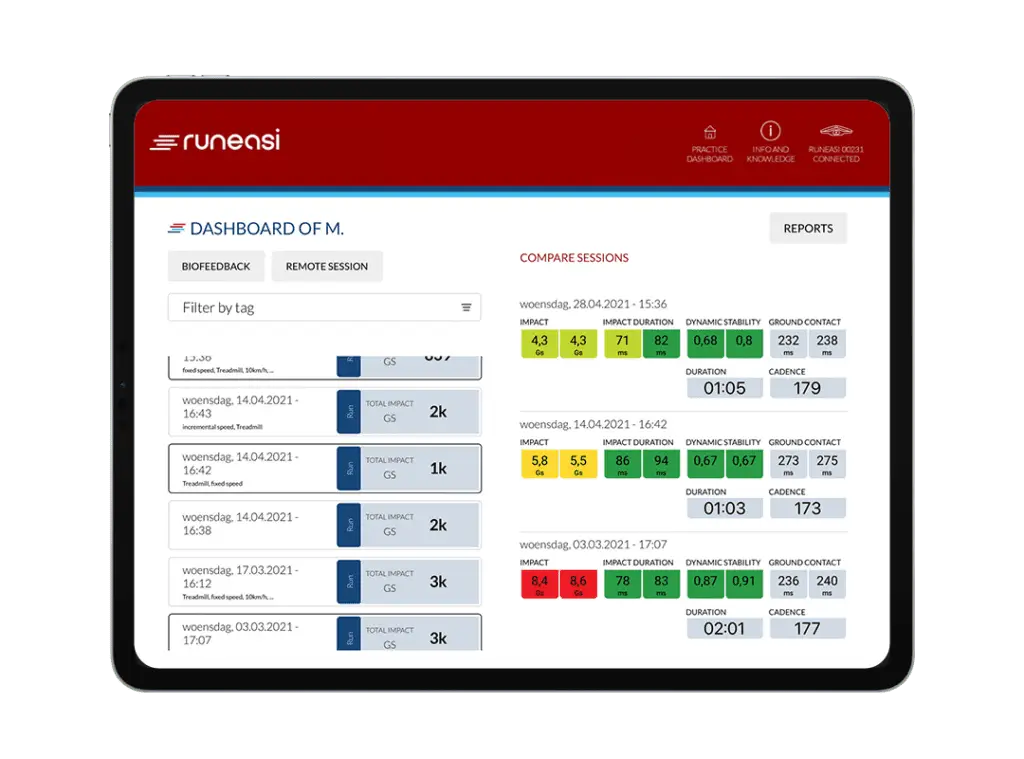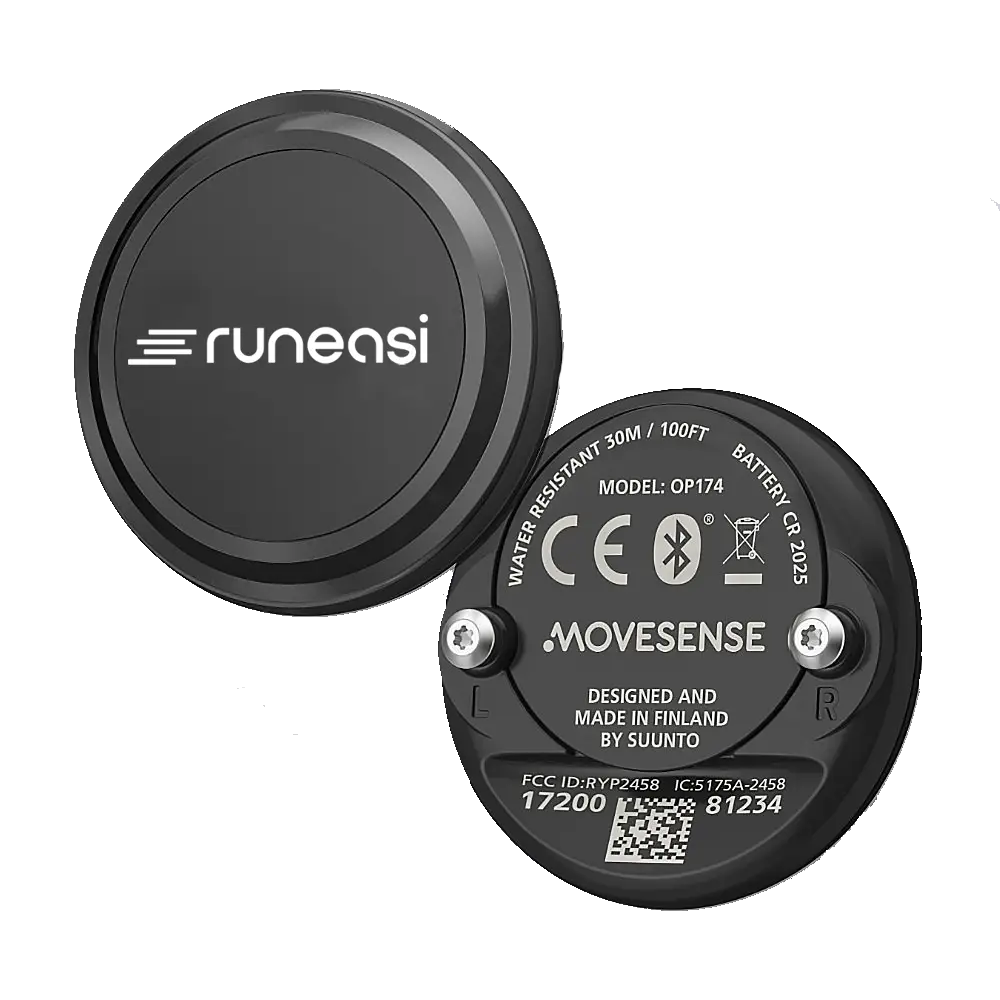Choose your weapon: wearables in physiotherapy
Translation of article by Lotte Kraus.
Injuries occur when the load capacity of structures does not align with the stress they endure. Repetitive, suboptimal movements and forces encountered in everyday work or sports often lead individuals to seek physiotherapy. Wearable technology is emerging as a vital tool in the fields of sports medicine and physiotherapy. Small, inconspicuous sensors that monitor movements in real-life or athletic situations liberate us from the constraints of traditional movement laboratories.
Most people are familiar with the ubiquitous smartwatch, with fitness-tracking bracelets dominating the market segment. Smart textiles are now capable of transmitting information about body temperature, while arm-worn trackers can measure blood glucose levels. Additionally, shin guards can assess lactate levels in athletes’ blood, and sensors embedded in shoes can count ball contacts and enhance technical development to make talent identification more objective and effective. In contact sports, sensors record the number, intensity, and acceleration of impacts. Furthermore, the product development of hockey sticks now incorporates ergonomic data gathered from wearables.
The range of applications for wearables appears limitless, especially as the technology becomes more cost-effective and nearly every tech manufacturer aims to capture a share of this growing market by developing wearable solutions. These devices are not merely gadgets from the entertainment industry that provide a sense of control during uncertain times; they also serve as essential tools for trainers and sports scientists to objectively measure sports-related stress. Increasingly, clinical applications are being identified, with wearables being utilized in randomized studies to further explore their benefits.
The Demands of Physiotherapists
Smartwatches and fitness trackers primarily serve to entertain and motivate users by transmitting specific activity data to them. On the opposite end of the complexity spectrum are university motion laboratories, which adhere to the gold standard in motion capture. Achieving this standard requires a large space and the synchronization of numerous cameras and sensors. However, even with such extensive setups, these environments remain laboratory-based rather than reflective of real-world conditions. Consequently, significant efforts in measurement technology and algorithm development are focused on making valid assessments with fewer sensors.
Between the realm of smartwatches and advanced scientific setups lies a vast landscape of nearly limitless opportunities for application in physiotherapy and sports medicine. However, navigating this landscape can be challenging.
Consumer Product or Medical Technology
Self-employed physiotherapists have distinct requirements for wearable measurement technology compared to consumers using smartwatches or the advanced measurement systems found in university or clinical gait laboratories. For physiotherapists, the technology must not only document patient data but also assist in determining therapeutic measures. Furthermore, it needs to be seamlessly integrated into a physiotherapeutic service, adhering to legal and accounting regulations. Typically, a self-employed physiotherapist must register a business to offer movement analysis services that utilize wearable measurement technology.
The service concept itself requires careful planning. Prehabilitation and functional training before surgical procedures are highly recommended. When movement analysis is employed to prevent potential injuries through early risk assessments, the focus shifts from therapy to the realms of prevention and performance assessment.
International comparisons indicate that physiotherapists in the Netherlands and Belgium are increasingly interested in preventive measures and the integration of technology into their practices. The Netherlands serves as a notable example of a healthcare system that has progressively shifted self-responsibility onto patients since a 2016 reform, garnering attention from German observers.
Remote movement analyses, regular consultations via subscriptions, and targeted prevention strategies for non-elite athletes are becoming less associated with “Silicon Valley” innovations and are now viewed as practical solutions within the field.
Insights from Kurt Schütte
In conversation with Kurt Schütte, the founder and CEO of Runeasi, a sensor-based running analysis developed specifically for physiotherapists, one sentence particularly stands out: “With wearables, data is continuously collected, and the physiotherapist can see the whole film, not just a single picture.” However, before we show interest in the film, the groundwork must be done. What should a physiotherapist consider when working with wearables?
Understanding Wearables
Wearables are portable electronic devices equipped with sensors and connectivity features that are worn on the body. They provide valuable data-driven insights into activity, health, and performance metrics such as distance, acceleration, force, among other things.
Accuracy
What is “accurate enough” depends on the question. In sports, wearables that transmit movement data are prevalent, such as GNSS and inertial sensor-based vests used in football. Seen during undressing or worn over training jerseys for advertising purposes, are accepted at the highest performance levels. Accuracy is not the focus here. The measurement data of the vests may let an athlete run a few hundred meters or even kilometers more or less than in reality. In certain physiotherapeutic or sports medicine situations, this would not be acceptable.
An inaccuracy that is acceptable or at least accepted in sports use because it is about roughly capturing movement data can be a disqualifying factor in patient-specific rehabilitation. Users must also be aware of possible misinterpretations. This means that comprehensive and continuous user training should always be included when implementing wearables.
Significance Of Data
Data interpretation is crucial. A good tool provides parameters that make clinical decisions faster, more valid, and transparent. Processing algorithms translate wearable sensor data into meaningful information. For example, there are 27 different ways to calculate ground reaction force – which is the most effective can depend on the clinical question. This explains why the number of biomechanical publications in the field of wearables has exploded in recent years.
Sebastian Wille, who has been developing solutions in the health sector for 20 years with his engineering company “Wille Engineering” and specializes in inertial sensor technology, says: “Assistance systems should – and can – always only represent support. The algorithms are only as good as the raw data of the sensors. Therefore, the results and recommendations issued by a sensor/app should always be critically questioned. The methods used are constantly being refined – but you should always also follow your common sense and gut feeling.”
Like highly processed foods: they can taste good, but they can also contain a lot of junk. And the packaging usually describes the worst in incomprehensible or misleading terms.
Practicality
From a physiotherapist’s perspective, scientific studies often require significant time to equip patients with sensors and synchronize measurement technologies while troubleshooting data transmission issues. During this time, a physiotherapist could have already treated multiple patients.
The optimal balance of data accuracy and practicality is the holy grail in measurement technology development – and like the holy grail: non-existent. Because what is considered practical depends on the application area.
User-Friendliness
Effective tools simplify work processes; ineffective ones complicate them. Sebastian Wille, an engineer by nature a proponent of “the more accurate, the better,” agrees with me that wearables for physiotherapy must be user-friendly. Logically, in practice, no one is paid to spend time attaching sensors. Not everyone wakes up wanting to search for abnormalities in an interface that looks like a wild Excel sheet, and then translate them into therapy-relevant statements.
Wearables for Physiotherapists
“I was very happy. Initially, I knew I could have done more—perhaps increased the frequency from once or twice a week to two or three times. But even with my modest effort, the improvement was remarkable.”
I asked Kurt from Runeasi about the biggest challenges in meeting the demands of physiotherapy. He highlights four points:
- A “Screenshot” is Not Enough: To optimally care for patients with chronic overuse symptoms or post-operative patients, more than a “screenshot” in practice is needed. The wearable solution must be usable outside, in reality.
- Enable Prevention and Prehabilitation as a Physiotherapeutic Service: Early detection of overuse risks prevents worse outcomes and motivates clients to change their behavior because they understand why.
- From Complex to “Actionable”: Data must be transmitted so that the expert does not need hours to analyze and translate it into comprehensible terms. And the great art: doing so without unacceptable compromises in accuracy and validity.
- Transparency Builds Trust: Objective data helps the client trust the therapist’s expertise and overcome skepticism. The collaboration between physio and client reaches a new quality level.
Takeaways
- Wearables are enablers and can shape the physiotherapy of the future.
- Wearable solutions are only as good as integrated sensor technology, processing algorithms, speed, and the reliability of data transmission.
- Wearables in physiotherapy practice should offer a good balance of data accuracy and user-friendliness.
- Wearable information is interpreted by the user. Therapy, training, or health measures determine – education and training on the use and limitations of technology and data are essential.
The selection of the optimal wearable measurement technology depends on many factors: application area, business strategy, or even the included service scope in the provider’s training and education of the team should always be considered.
Click here to read the original article.

Translated Interviewed by Lotte Kraus
Lotte Kraus is a skilled physiotherapist with a Master's degree in Physiotherapy from the University of Applied Sciences in Amsterdam. She has extensive experience in clinical and rehabilitation settings, emphasizing patient-centered care and evidence-based practices. Passionate about professional development, Lotte actively participates in workshops to enhance her skills and knowledge. Additionally, she is interested in integrating technology into physiotherapy to improve patient outcomes and promote innovative treatment approaches.







